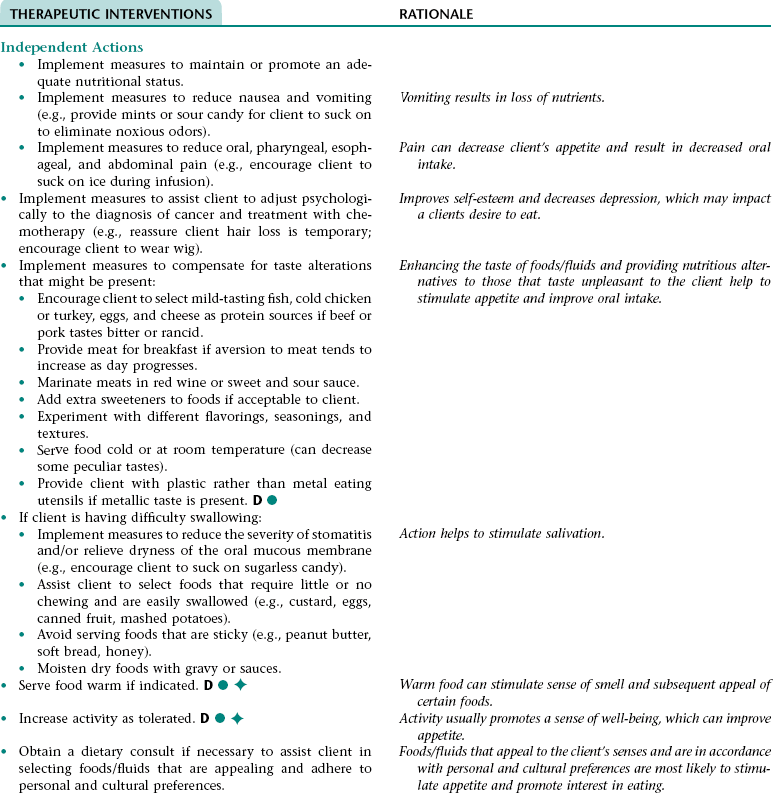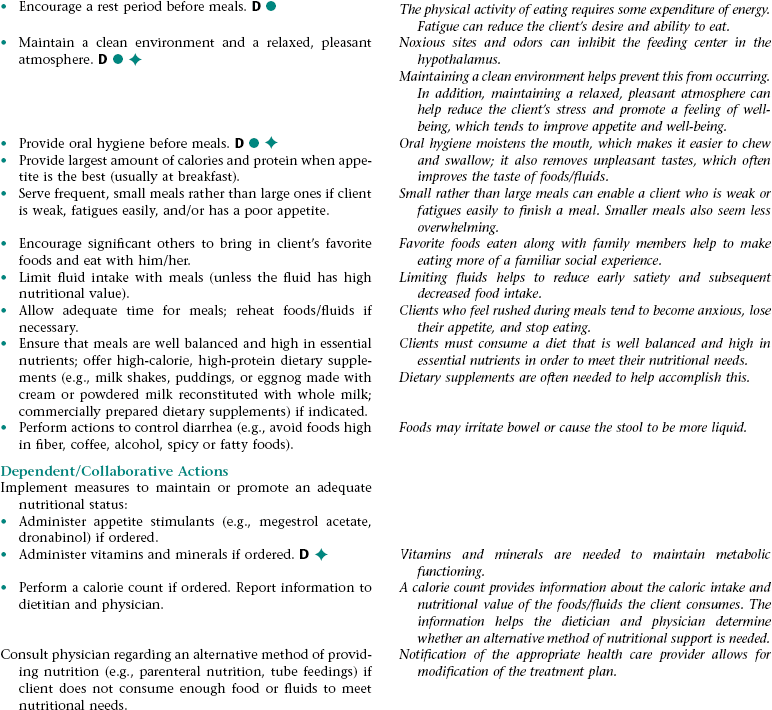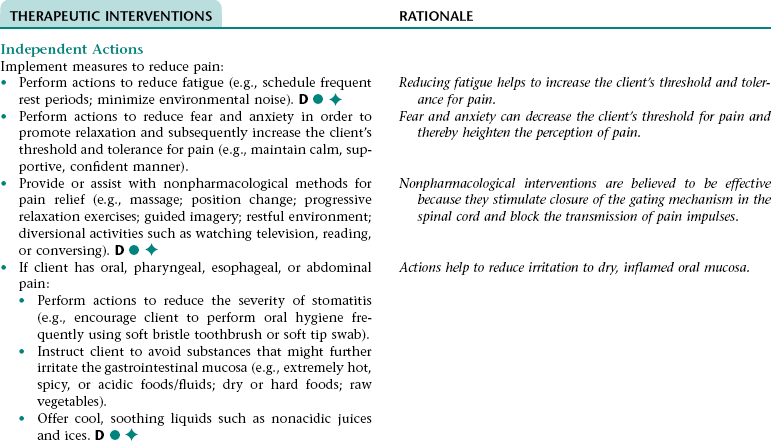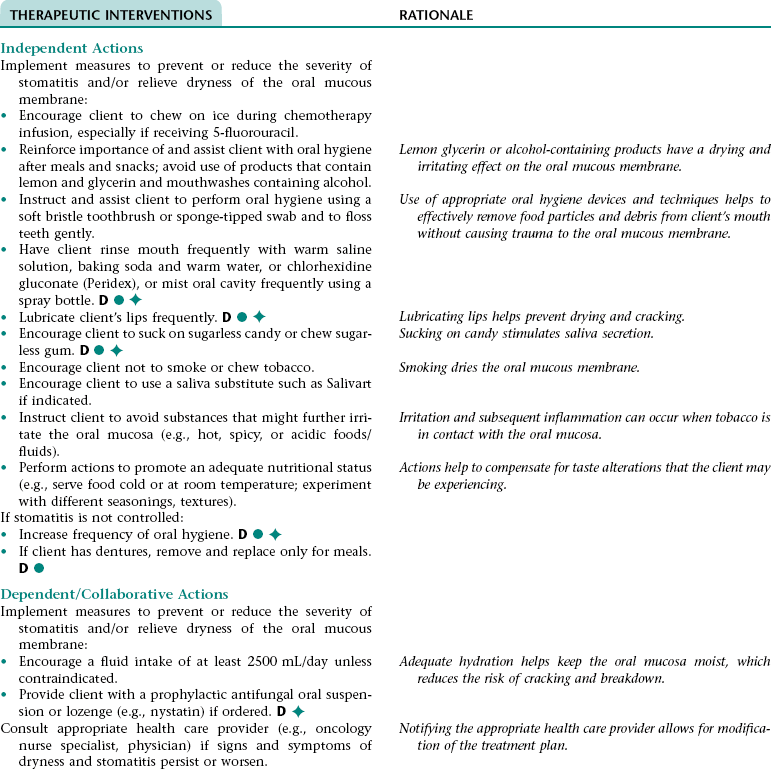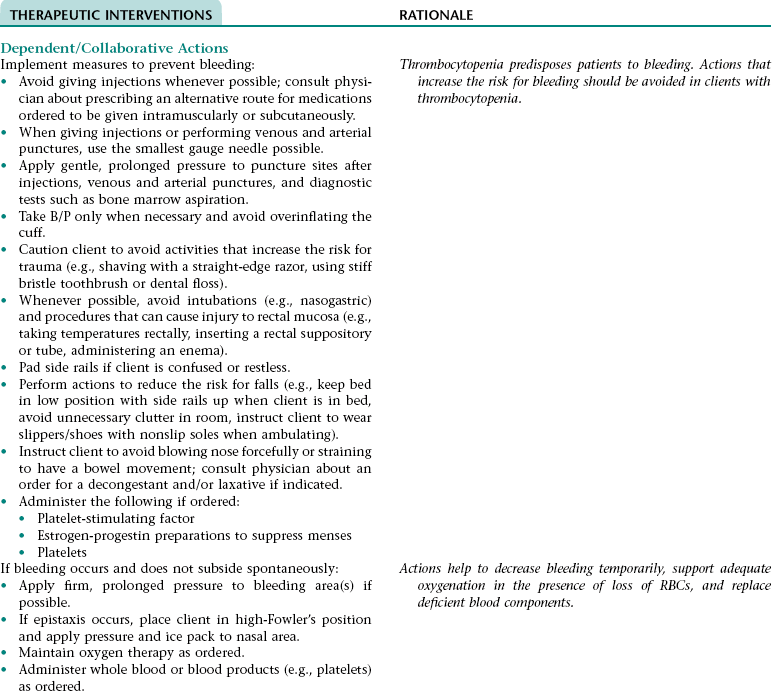CHAPTER 14 1. Have no signs and symptoms of toxic effects of cytotoxic agents 2. Have side effects of cytotoxic agents under control 3. Have fatigue at a manageable level 4. Have an adequate or improved nutritional status 5. Identify ways to prevent infection during periods of lowered immunity 6. Demonstrate appropriate oral hygiene techniques 7. Identify techniques to control nausea and vomiting 8. Verbalize ways to improve appetite and nutritional status 9. Verbalize ways to manage and cope with persistent fatigue 10. Verbalize ways to prevent bleeding when platelet counts are low 11. Verbalize ways to adjust to alterations in reproductive and sexual functioning 12. Verbalize ways to promote independence and prevent injury if neuropathies are present 13. Demonstrate the ability to care for a central venous catheter, a peritoneal catheter, or an implanted infusion device if in place 14. Verbalize an understanding of the care and precautions necessary if an Ommaya reservoir is in place 15. Verbalize an understanding of an implanted infusion pump and precautions necessary if one is in place 16. State signs and symptoms to report to the health care provider 17. Share thoughts and feelings about changes in body image resulting from chemotherapy 18. Identify community resources that can assist with home management and adjustment to the diagnosis of cancer and chemotherapy and its effects 19. Verbalize an understanding of and a plan for adhering to recommended follow-up care including medications prescribed and schedule for chemotherapy, laboratory studies, and future appointments with health care provider Definition: Intake of nutrients insufficient to meet metabolic needs • Decreased oral intake associated with: • Oral, pharyngeal, and esophageal pain and difficulty swallowing resulting from mucositis if it has developed • Anorexia resulting from factors such as depression, fear, anxiety, fatigue, discomfort, early satiety, altered sense of taste and smell, and increased levels of certain cytokines that depress appetite (e.g., interleukin-1, tumor necrosis factor) • Altered mental status (can result from fluid and electrolyte imbalances, hypoxia, or tumor involvement of the brain) • Loss of nutrients associated with vomiting and diarrhea if present • Impaired utilization of nutrients associated with: • Accelerated and inefficient metabolism of proteins, carbohydrates, and/or fats resulting from factors such as increased levels of cortisol, glucagon, and certain cytokines (e.g., tumor necrosis factor, interleukin-1) • Decreased absorption of nutrients resulting from loss of intestinal absorptive surface if mucositis has developed • Utilization of available nutrients by the malignant cells rather than the host • Oral, pharyngeal, esophageal, and/or abdominal pain related to mucositis associated with the effects of cytotoxic drugs on the rapidly dividing cells of the gastrointestinal mucosa • Muscle and bone pain (the cause is not known but it sometimes occurs in persons receiving paclitaxel and high doses of vinblastine or etoposide) • Neuropathic pain related to the effects of some cytotoxic drugs (e.g., paclitaxel, cisplatin, vinca alkaloids) on the peripheral nerves Definition: Disruption of lips and soft tissue of the oral cavity Dryness related to reduced oral intake • Malnutrition and inadequate oral hygiene • Disruption in the renewal process of mucosal epithelial cells associated with toxic effects of cytotoxic drugs (particularly antimetabolites, antitumor antibiotics, mitotic inhibitors, and taxanes) • Infection, particularly gingival, during the period of myelosuppression Definition: Escape of blood from an injured vessel. Related to: Thrombocytopenia associated with chemotherapy-induced bone marrow suppression DESIRED OUTCOMES: The client will not experience unusual bleeding as evidenced by: Definition: Inability of the kidney to appropriately concentrate urine and excrete waste products • Direct toxic effects of some cytotoxic agents (e.g., cisplatin, high doses of methotrexate, streptozocin) on renal cells • Nephropathy associated with: • Excessive uric acid accumulation resulting from the rapid lysis of large numbers of tumor cells • Precipitation of certain drugs (e.g., high doses of methotrexate) in the renal tubules and collecting ducts as a result of low urinary pH and inadequate hydration before, during, and after drug administration
The Client Receiving Treatment for Neoplastic Disorders
CHEMOTHERAPY
OUTCOME/DISCHARGE CRITERIA
Nursing Diagnosis IMBALANCED NUTRITION: LESS THAN BODY REQUIREMENTS NDx
Nursing Diagnosis ACUTE/CHRONIC PAIN NDx
Nursing Diagnosis IMPAIRED ORAL MUCOUS MEMBRANE NDx
Collaborative Diagnosis RISK FOR BLEEDING
Collaborative Diagnosis RISK FOR IMPAIRED RENAL FUNCTION
The Client Receiving Treatment for Neoplastic Disorders
Get Clinical Tree app for offline access


